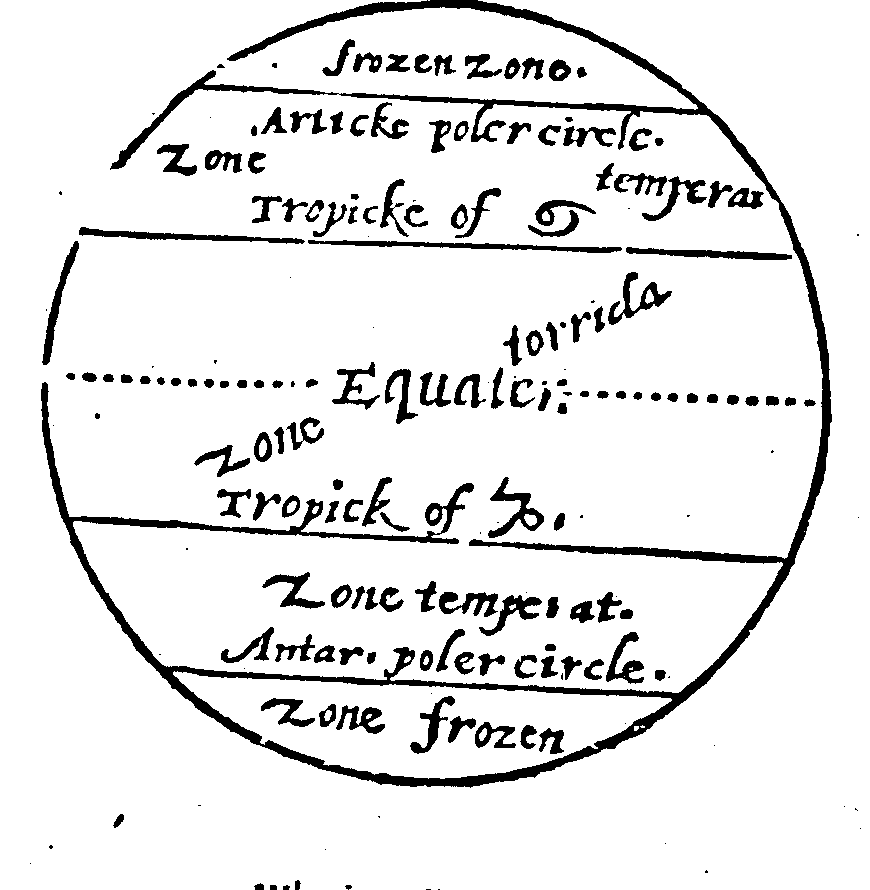
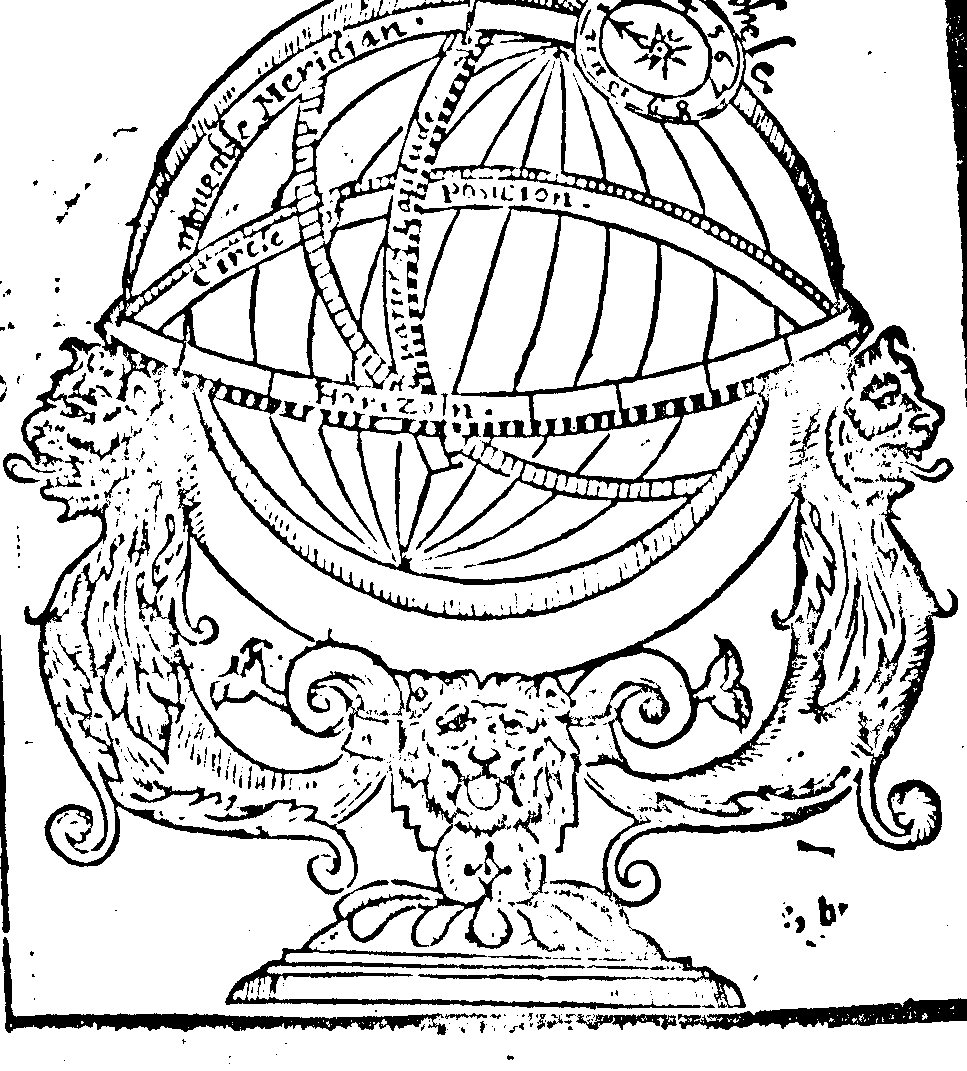
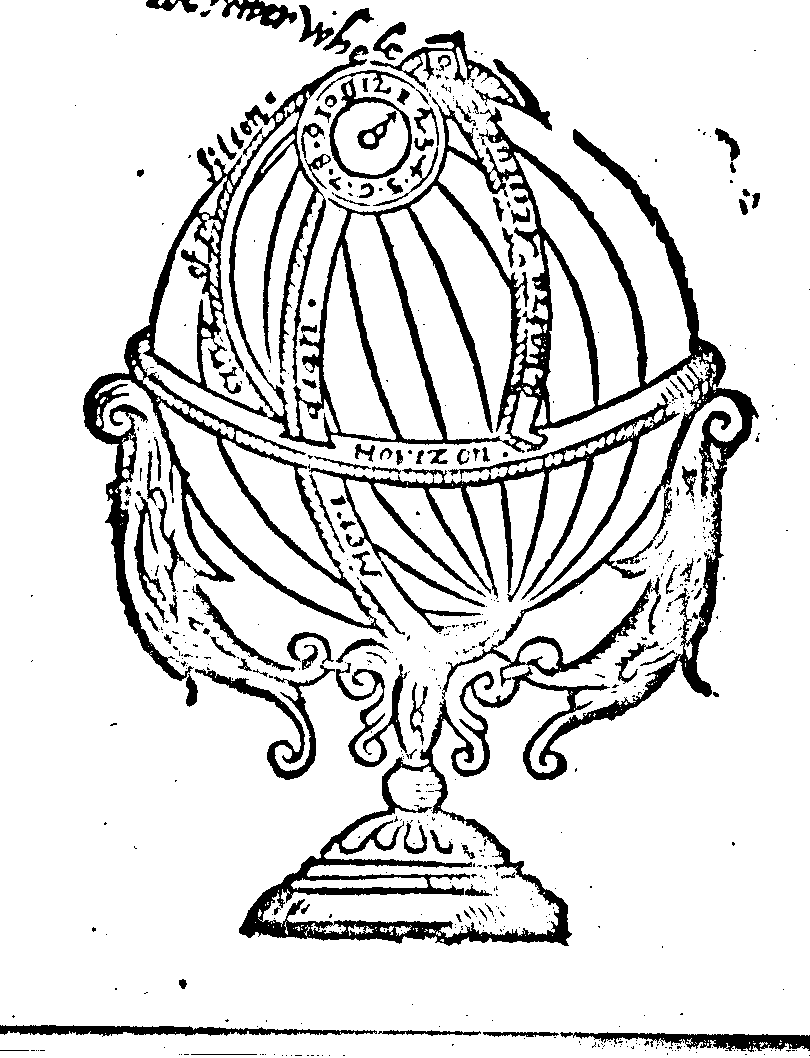
----------------------------------------------------------------------
NOTE
* dimetient = dimension ?
* tracheth = trace eth ?
----------------------------------------------------------------------
How many Zones be there ?
There are Five Zones, Two Temperate Zones, Two Frozen
Zones,& one burning Zone: the burning zone lieth between 2 tro-
picks, whose latitude is 46 deg. 56 min. which zone by ancient Geo-
graphers is reported to be not habitable, by reason of the great heat,
which they supposed to be, through the perpendicularity of the suns
beame, the perpetual motion is within the said zone, but we find in
our travels, contrary to their report, that it is not only habitable,but ve-
ry populous, containing many fameous and mighty Nations, & yieldeth
in great plenty the most purest things that by natures benefits the earth
may procreat: Twice I have sayled through the Zone, which I found
in no sort to be offensive, but rather comfortable unto nature, the extre-
mity of whose heat is not furious, but tollerable, whose greatest force
lasteth but 6 hours, that is from 9 of the clock in the morning unto 3 in
the afternoon, the rest of the day and night is most pleasing and delight-
ful: therefore they did nature wrong in their rash report.
Of the Frozen Zones.
The Frozen Zones are contained within the Polar circle, the Ar-
tick Frozen Zone within the Artick Polar circle, & the Antarctick
frozen zone; within the Antarctic polar circle, which are also reported
not to be habitable,by reason of the greater extremity of cold,supposed to
be in those parte, because of the Suns far distance from those zones, but
in these our dayes we find by experience that the ancient Geographers
had not the true consideration of the nature of those zones,for three times
I have been within the Arctic frozen Zone, Where I have found the aye
very temperate, yea and many times in calm weather marvelious hot:
I have felt the Suns beams ot as forcible action within the frozen zone
in calms near unto the those, as I have at any time found within the bur-
ning zone: this zone is also inhabited with people of good nature, shape.
and tractable conditions, with whom I have conversed, and not found
them rudely barous, as I have found the Canibals which are in the
Straits of Magilane, and Southern parts of America: In the frozen zone
I discovered a Coasr which I named Desolation, at the first view where-
of supposing it by the loathsome shape to be waste and desolate, but when
I came to Anchor within the Harbors thereof, the People presently
came unto me without fear, offering such proz things as they had to Ex-
change for Iron Nails,& suchlike: but the Canibals of America flee the
presence of men, shewing themsleves in nothing to differ from brutt
beasts:thus by experience it is most manifest that those zones which have
been enformed desolate & waste, are habitable, inhabited & fruitful. If any
man be persuaded to the contrary of this truth, he shall so himself wrong
in having so base an imagination of the excellency of Gods Creation, as
to think that God Creating the world for mans use, and the same being
devided but into 5 parts, three of those parts should be to no purpose:
But let this saving therefore of the Prophet Esay be your full satisfacti-
on, to confirm that which by experience I have truly spoken: For thus
saith the Lord that created the heaven,God himself that framed the earth,and
made it,he that prepared it, he created it not in vain, he framed it to be
inhabited, &c. Esay 45.18.
Of the Temperate Zones.
The Temperate Artick Zone is included between the Tropick of
Cancer and the Artick Polar circle, whose latitude or breadth is 42 deg.
2 min. within the which we have our habitation.
The Temperate Antartick Zoneis limited by the Tropick of Capricorn, &
the Antartick Poler circle, & hath breadth or latitude 42 deg. 2 min.
|
frozen zone
------------------------
Articke poler circle.
Zone temperate
Tropicke of Cancer
--------------------------------------
- - - - - - - E q u a.t o r - - - - - - - - -
Tropicke of Capricorn
--------------------------------------
Zone temperate
Antar. poler circle.
--------------------------
Zone frozen
|

What is a Climate ?
A Climate is the space of difference upon the upper face of the earth,
included between two parallels, wherein the day is sensibly leng.
thened or shortened half an hour, for as you travel from the Equator to-
ward the Arctick Pole, the Sun having North declination, the dayes do
grow longer and longer until at last the Sun not setting under the Ho-
rizon, you shall have continual day, and every space or distance that al-
tereth the day hald an hour, is called a Climate: these Climates take
their names from such fameous placea are within the said Climates,
of which there are nine, as by their distinctions may appear.
1. The first passing through Meroe, beginneth in the latitude of 12
deg. 45 min.& endeth in 12 deg. 30 min. whose bredth is 7 deg. 45 min.
2. The second passing through Syene, beginneth in the latitude of 20
deg. 20 min.& endeth in 27 deg. 30 min. whose breadth is 7 deg.
3. The third passing through Alexandria, beginneth in the latit. of 27
deg. 30 min.& endeth in 33 deg. 40 min. whose bredth is 6 deg. 10 min.
4. The fourth passing by Rhodes, beginneth in the latitude of 33 deg.
40 min. & endeth in 35 deg. whose breadth is 5 deg. 20 min.
5. The fifth passing by Rome, beginneth in the latitude of 39 deg. and
endeth in 43 deg. 30 min. whose breadth is 3 deg. 45 min.
6. The fifth passing by Boristhines, beginneth in 43 deg. 30 min, and
endeth in 47 deg. 15 min. whose breadth is 3 deg. 45 min.
7. The seventh passing by Riphxan mountains, beginneth in 47 deg.
15 min & endeth in 50 deg. 20 min. whose breadth is 3 deg. 5 min.
8. The eigth passing by Mxotis, or Londen, beginneth in 50 deg. 20
min. and endeth in 52 deg. 10 min. whose breadth is 2 deg. 50 min.
9. The ninth passing by Denmark, taketh his beginnign in the latit.of
53 d. 10 m. & endeth in the lat. of 35 d. 30 m. & hath in bredth 2 d. 20 m.
If you desire to know how many leag. every climate is in bredth allow
for every deg. 20 leag. or 60 m les.& for every min. a mile, so is the di-
stance given. Thus have I manifested unto you all the divisions and
particularities of the Spheres distinction.
(circle demonstrating the above is set below)
| ----------.----------+----------.---------- |
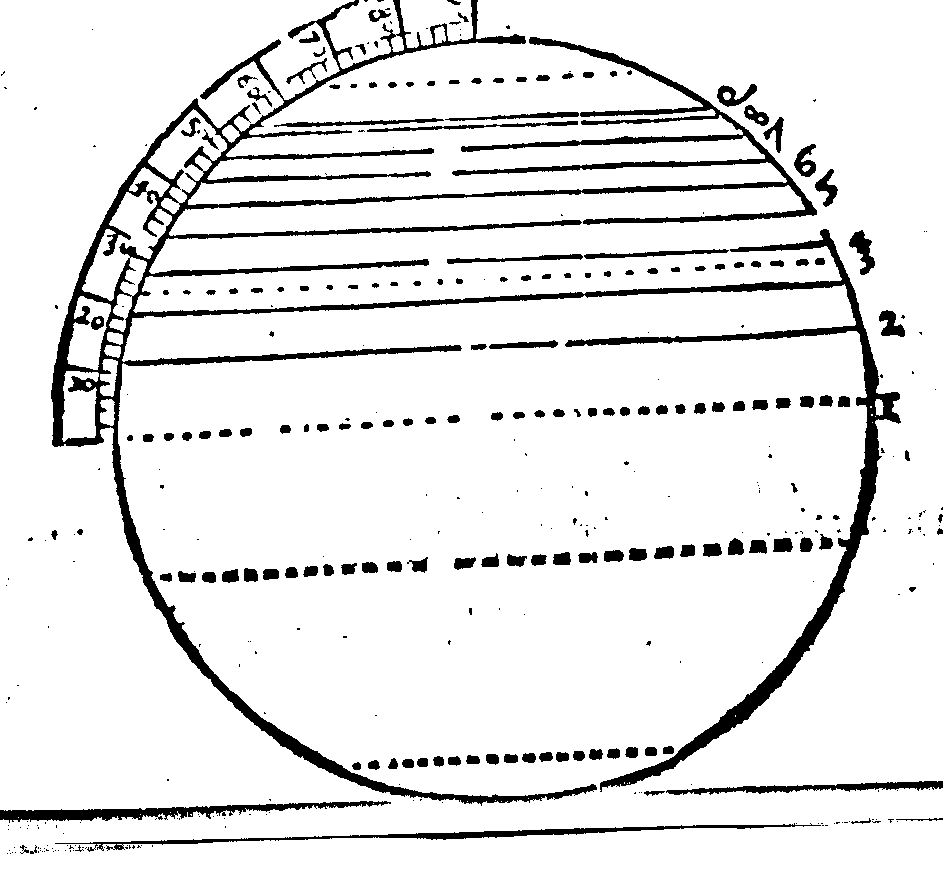
What is the use of the Globe ?
The use of the Globe is of the great ease, certainly,& pleasure as that
the commendations thereof cannot sufficiently be expressed, for of all
Instruments it is the most rare and excellent, whose conclusions are in-
fallible, giving the true line, angle, and circular motion of any Corse or
Travers that may in Navigation happen, whereby the longitude and
latitude is most precisely known, & the certainy of distance very plain-
ly manifested accorning to the true nature thereof: it giveth the variati-
on of the Compass, and the hour or time of the day at all seasons, and
in all places. And by the Globe, the Poles height may at all instants,&
upon every point of Azumuth of the horizon by the Suns altitude taken,
be most precisely known, by the certainty of whose excelltnt use the skil-
ful Pilot shall receive content in his pleasing practise governautick.
How are distances measured upon the Globe ?
When there are tow places alfianed*, the distance between which you
desire to know, with a pair of circular Compasses you must do it
in this sort: set one foot of the Compasses upon one of the places,& the
other foot upon the other place, the Compasses so stretched forth, bring
unto the Equator, and as many degrees as may be contained between
those two points of the Compass, allowing 20 leagues for every degree,
is the distance desired: or if the places be of such distance as that you
cannot with your Compasses reach them, then take with your Compas-
ses 5 deg. of the Equator which is 100 leag. or 10 deg. for 200 leag.
and so measure how often the distance is contained between the said pla-
ces, if any part of a Degree both remain, for hald a deg. allow 10 leag.
for a quarter 5 leag.&c. But if you desire a most exquisite preciseness in
measuring of the minute, second & third, then do thus, when your Com-
passes do fall upon any part of a deg. note the distance between the end
of that deg: and the point of the Compasses, then with a pair of conveni-
ent Compasses take the distance, then measure the same 60 times upon
the Equator,(beginning at some certain place) then consider how ma-
ny deg. are contained within the measure, and allow every deg. to be a
min. or mile,so are the leagues and miles known, if any part of a deg.
remain upon the measure of min. do as at the first, measuring the same
60 times upon the Equator, the degrees comprehended within the mea-
sure, are seconds: if any parcel of a deg. remain upon those seconds, do
as in the first, and the deg. contained in this measure are thirds, and so
you may proceed infinitely.
How may the Globe be rectified answeravble to the true position
of the Heavens, for any place, or promontory.
The place being known for which you would rectifie the Globe, do
thus: Bring the place under the Meridian, and there consider the
latitude thereof: and as many deg. as that place is from the Equator,
so many deg. you must elevate the Pole from the horizon, then bring the
Zenith directly over the same place,& so is your Globe rectified for the
Execution f any practise: and without this ordering of the Globe, there
is no conclusion to be executed by the same.
How is the Longitude of places known by the Globe ?
By turning the Globe within the Meridian, you must bring the Pro-
mentory Bay, Harborow, City, or other place (whole latitude and
longitude you seek) precisely under the Meridian, there holding the
Globe steady, the degree of the Meridain that is directly over the said
place, wheweth the latitude thereof, and that degree of the Equinoctial
which is directly under the Meridian is the longitude of the same place.
How is the Corse found between place and place ?
Two places being assigned the Corse between which you desire to
know, first sek the latitude of one of these places,& rectifie the globe
answerable unto the same, as before is taught, then bring that place di-
rectly under the Meridian & Zenith, if both places be under your Me-
ridian, they then lye North and South, if not then, bring the Quarta al-
titudo to either place, and note upon what part of the horizon the end
of the same tougheth, for that is the precise horizontal Corse between the
said places; but this you must consider, that the horizontal Corse is not
the Navigable Corse, unles the places be of smal distance, for if any
place bear northeast from me or east from me, or upon any other point,
North or South excepted, and be distant 500 leagues, if I sayl upon the
Horizontal Corse, I shall never arive unto the same place.
How then shall the Pilot sail by the Globe, if the
matter be so doubtful ?
The skilful Pilot that useth this excellent Instrument, doth first con-
sider the place from whence he shapeth his Corse, and rectifieth the
Globe answerable to the same, then bringing the place directly under the
Meridian and zenith, there holding the globe steady, bringeth the quar-
ta altitudo to the place for which he is bound, the end of whereof sheweth
upon the Horizon the true horizontal Corse, upon which Corse he saileth
20 or 30 leagues, and there maketh a note or prick by the edge of his
Quarta altitudo, according to the true distance proved by corse, reckoning
an altitude as in the use of a Chart: then he bringeth that prick or note
under the Meridian, and there considreth the true latitude of his being,
he then rectifieth the Globe answerable to the same prick, and keeping
the same under the Zenith, both again turn to the quarta altitudo, to the
place for which he is bound, the end whereof sheweth upon the Horizon
the horizontal corse, then sayling as the first, he maketh a note or prick
as before, and thus prosecuting his Corse, shall arive unto his desired
place: but in this practice he shall plainly prove that his horizontal corse
will differ greatly, and that by his sayling in this sort, he shall by his
notes and pricks describe the true Navigable I neerest Corses between
the said places: The like Method is to be observed upon any travers or
forced course whatsoever: and therefore the Pilot must take care that
althouth the wind be never so favourable, yet he must not prosecute any
Horizontal Corse (North and South only excepted.)
Therefore I say, the Pilot must take special care to consider the di-
stance of places, whether the Horizontal Corse will lead him between
the said places: for if places be more than 45 degrees asunder, the hori-
zontal Corse is not the mean to finde those places: unless they lye North
and South: for the horizontle course between any two places, is a por-
tion of a great Circle, which being of large distance, must be performed
by a great circle Navigation, and not be Horizontal corses: for the col-
lection of many Horizontal Corses being knit together, do perform a
Paraboral motion, altogether differing from a great circle: as for ex-
ample: Being at Cape Verde, there is a place distant from me 80 deg.
upon the point Northwest, unto which place I desire to sayl, I therefore
bring Cape Verde, under the Meridian of my Globe, there considering
the latitude of the Cape, I raise the Pole answerable to the same, and
place the Zenith directly over the Cape, then turning the quarta altitudo
to the point northwest upon the horizon all such places as the said quarta
altitudo then toucheth, do bear due Northwest from me now prosecuting
this Corse by the direction of my Compass, the first day I sayl 20 leag.
therefore I make a mark by the edge of the quarta altitudo 20 leag. from
the Zenith, then bringing that mark under the Meridian I rectify the
Globe answerabel to the latitude thereof, the next day I sayle other 20
leagues upon the same point, and make a mark as at the first. I bring
that mark likewise under the Meridian, and rectifie the Globe as be-
fore, and by this Method prosecuting the Corse N.W. I shall describe a
paradoxal line, which will lead me to the North of the place unto which
I would sayl, the farther distance, the greater the difference: by
this Order you may describe paradoxal lines upon all the points of the
Compass, but this is to be regarded, that your differences be as small as
you may, and that none of them exceed 20 leagues, for by the smallest
distinctions is performed the greatest certainty. And by the description
of these lines you may very manifestly understand the differnce of
Horizontal, Paradoral, and great Circle Navigation.
And this may suflice for the sayling use of the Globe, convenient for
the Seamans purpose.
What is the great Circle navigation ?
Great Circle Navigation is the chiefest of all the 3 kinds of sayling,
in whom all the other are contained, and by them this kind of sayl-
ing is perfomed, continuing a Corse by the shortest distance between
places, not limited to any one Corse, wither horizontal or paradoxal, but
by those Corses are Ordered to the full perfection of this rare practice,
whole benefits in long Voyages are to great purpose, ordering and dif-
posing all horizontal traverses to a perfect conclusion: for there are ma-
my changes of horizontal and paradoxal Corses in the execution of this
practise, so that upon the shifting of a wind, when that it may seem that
you are forced to an inconvenient corse by the skill of great Circle sayl-
ing, that corse shall be found the shortest and only proper motion to per-
form your voyage. And also when with favourable winds the pilote
shall shape a Corse by his Chart or Compasse paradoxall, as the best
meane to attaine his Port, he shall by this kinde of sayling finde a bet-
ter and shorter Corse, and by sufficient demonstration prove the same,
so that without this knowledge I see not how Corses may be ordred to
their best advantage: therefore with by it the perfection of sayling is
largely understod, and the errour likewisemost substantially contro-
led, it may of right challenge the chiefest place among the practises Ou-*
bernautik. The particularities whereof if I should by an orderly me-
thod labour to express, it would be a discourse over-large for this place,
no I think troublesome if the premises be not well understood: therefore
I will now over-pass it, until a time more convenient, and of better
pleasure.
Of Paradoxal Navigaton.
Paradoxal Navigaton, demonstrateth the true motion of the ship up-
on any Corse assigned, in his true nature by longitude, latitude, and
distance, giving the full limit of determination of the same, by which
motion, lines are described neither circular nor strait, but concurred or
winding lines, and are therefore called paradoxal, because it is beyond
opinion that such lines should be described by plain horizontal motion: for
the full perfection of which practise I purpose (if God permit) to pub-
lish a paradoxal Chart, with all convenient speed and so will discover
by the same at alrge all the practices of paradoxal and great circle na-
vigation, for upon the paradoxal Chart, it will best serve the Seamans
purpose. being an instrument portable, of easie stowage and small pra-
ctise, performing the practises of Navigation as largely and as benefici-
ally as the Globe in all respects: and all these practices of sayling before
mentioned, may in a general name be aptly called Navigaton geome-
trical, because it wholly consisteth of Geometrical demonstrative con-
clusions.
But there is another knowledge of Navigation, which so far excel-
leth all that is before spoken, or that hach hitherto been vulgarl y practi-
sed, as the substance his shadow or as the light surpssseth the thick ob-
scured darkness: and this sweet skill of sayling may well be called Na-
vigation arithmetical. because it wholly consisteth of calculations, com-
prehended within the limit of numbers, distingushing corses not only
upon the points of the compass, but upon every degree of the horison, and
giveth the distance of any Travers for the particular elevation of mi-
nuts, yea, and less parts assure your self: it giveth longitudes and lati-
tudes to the minute, second, and third: in so great certainty, as that by
other means the like cannot be performed: if teacheth the nature of angles
and triangles, as well spherical as plain superficial and soled commen-
formations, the effort of lines Grais*, circular, & paradoxal, the quantities
and proportons of parallels, the nature of Horizons, with every parti-
cular distinction of any alteration whatsoever, that may in Navigation
be required to a most wonderfull precise certainty: for there can nothing
be required, that by this heavenly harmony of numbers shall not be most
copiously manifested to the Seamans admiration & great content: the
orderly practice thereof, to the best of my poor capacity, I propose to
make known, if I may perceive my pains already taken, to be received
in good part, which I distrust not but all honest-minded Seamen & Pi
lots of reputation will gratefully embrace, only in regardd of my friend-
ly good will towards them, for it is not in respect of my pains, but of my
love, that I would receive favorable curtesie.
How may the Poles height be known by the Globe ?
There are divers ways to find the Poles height up the Globe, as well
from the Meridian as upon the* same, but with before I have suffi-
ciently taught how by the Suns Meridian Altitude, the Poles height
may be found. I will therefore in this place speak no further thereof, but
for the other kinds it may be known as followeth:
How by the Suns Rising or Setting, the Poles height
may be known.
By your Compass of variation or some magnetical instrument, ob-
serve at the Sun rising, uon what degree of the Horizon the Cen-
ter toucheth according to the true horizontle position of the Magnet, all
variation duly considered, that being known search in the Tables of the
Ephimerides, for the Suns place in the Ecliptick, at the time of your
observation, then bring that place or degree of the ecliptick wherein you
find the Sun to be to the Horizon, and move the Meridian of the Globe
as occasion requireth, until that observed degree of the Horizon and
the Suns place in the Ecliptick so justly touch together, for then is
the Pole in his due Elevation, as by the intersection of the Horizon and
Meridian may appear, in like sort you may find the Poles Altitude, by
any known fixed Sar* in the Horizon.
To find out the Poles height by the Sun, upon any point
of the Compass.
By the Compass of variation, rectified to the true horizontal position
observe the Sun until he come to any point thereof at your pleasure,
and in the same instant take the Suns height from the horizon, then
bring the quarta altitudo to that point of the Compass upon the horizon
of the Globe where you observe the Sun to be, there holding the quarta
altitudo steady, move the Globe until you bring the degree of the Eclip-
tick (wherein the Sun is at the time of your observation) unto the
edge of the quarta altitudo, if it fall upon that degree of Altitude as was
the Suns observed height, then doth the Pole stand to his true Eleva-
tion, but if it agree not, you must elevate or depress the Pole as occa-
sion requireth, rectifing the Zenith anserable thereunto. And a-
gain make tryal as at the first, bringing the place of the Sun to the
----------------------------------------------------------------------
NOTE
* original text for preceeding 2 words are unreadable .
"upon the" is a best guess.
* Sar = Star ?
-----------------------------------------------------------------------
quarta altitudo, and setting the same upon the observed point of the
Compass, until it agree in all respects with your observation, and then
the Meridian sheweth in his interaction with the Horizon, the eleva-
tion of the Pole from the Horizon.
To find the Poles height by any given Azumuth by
the Sun being above the Horizon.
By your Magnetical Instrument, or Compass of variation, observe
the Azumuth of the Sun at any time in the forenoon, or afternoon,
the nearer the Sun is to the horizon, the better shall be your observation.
and at the same instant take the height of the Sun from the horizon, keep
these two numbers in memory, and note that the Azumuth be observed
according to the true position of the horizon, by having good regard to
the variation of the Compass, then bring the quarta altitudo to the place
of the Sun in the Ecliptick, and set that degree of the Suns place in the
Ecliptick upon the observed degree of Altitude by the graduation of the
quarta altitudo, and if the end thereof at the same instant do fall right up-
on the observed deg. of Azumuth, then is the Pole in his due elevation:
if not thenraise or lay the Pole as occasion requireth, alwaies regard-
ing that you place the Zenith ansewerable to the Poles altitude, & then
again bring the Suns place to his altitude upon the quarta altitudo, and
look again whether the end thereof do touch the observed deg. of the Azu-
muth upon the horizon, if not, you must prosecute this order, until at one
instant the place of the Sun be upon his true Almicanter, by the edge of
the quarta altitudo,& that the end of the quarta altitudo do also touch the
observed deg. of Azumuth upon the horizon, for then is the Pole in his
true elevation, as by the Meridian and the Horizon will appear.
To find the Poles height by the Sun, by any two given Azumuths,& Alti-
tudes, not regarding the true horizontal position, or needless variations.
Beccuse there may great errors be committed in the former observati-
ons, unless the Compass be perfectly well rectified, so as it may re-
spect the true parts or distinctions of the horizon, it is not amiss to inform
you how without regard of variation, the poles height may be found.
Therefore by your Magnetical instrument or Compass of variation,
observe the Suns Azumuth, without regard of the true horizontal positi-
on, and at the same instant observe also his Altitude from the horizon,
keep those two numbers in memory, then after the Sun hath moved a
point of two points of the Compass more or less at your discretion, ob-
serve again his Azumuth and Altitude as at the first, then consider
the ark of the Horizon, through which the Sun hath moved between
those two Observations, for by the two Observations of the Suns
Altitude and by the degrees of Azumuth through which the Sun hath
moved, the Poles height is thus known: First, set the Globe to the
Elevation of the place wherein you are as neer as you can guess, and
bring the Zenith to the like latitutde from the Equator, as the poles ele-
vation is from the horizon, then bring the quarta altitudo to the place of
the Sun upon the ecliptick, for the time of your observation, there place
the Sunupon the first observed altitude by the degrees of the quarta alti-
tudo, and not the degree of the Horizon which the quarta altitudo then
toucheth: this done, bring the Suns place to the second observed altitude,
by touching the quarta altitudo & the globe until the degree of the Suns
place in the ecliptick, and the degree of his altitude upon the quarta alti-
tudo do meet. Then again consider the degrees of the horizon, which the
end of the quarta altitudo toucheth, and note the ark of the Horizon con-
tained between your two Observations, of how many degrees it con-
sisteth, if it agree with the observations made by your Magnetical In-
strument, then doth the Pole stand in his true altitude, if not, you must
either raise or depres the Pole, and again prosecute the former practice,
until you finde such Azumuths and Altitudes upon the Globe, as you
found by your Magnetical observations, for then the Pole doth stand in
his true altitude, and then doth also appear the true Azumuth of both
your observations, which if it agree not with your Compass, then is
your Compass varied, and may hereby be corrected, so that this doth not
only give the poles height, but also the true horizontal position without
errour.
To find the Poles height by taking the Suns altitude above the
Horizon, so that the precise time of any such Ob-
servation be known.
If you desire at any time of the day to know the Pole height, as at 8,
9, or 10 of the clock,&c. mark diligently the time of your observa-
tion, at what instant you observe the Suns altitude from the horizon
the time and altitude thus known, bring the place of the ecliptick where-
in the Sun is at the time of your observation directly under the Meri-
dian, there holding the Globe steady, bring the Index of the Circulus ho-
rarius to the hours of 12, or noon, then move the Globe until the Index
come to the hour of your observation, there hold the Globe steady, then
bring the quarta altitudo to the place of the Sun in the ecliptick, if it a-
gree with your observed altitude, then both the Pole stand in his true
Elevation, if not, move the Meridian by raising or depressing the pole
as occasion requireth, until you bring the altitude and the hour to agree,
and then you have the Poles height, and by the end of the quarta altitudo
doth also appear the degree of Azumuth, whereupon the Sun was at the
time of your observation, and note that in raising or depressing the Pole
of the Globe, you must also place the Zenith so far from the Equinocti-
al, as the Pole is from the Horizon; for this is a general rule, that so
much as the Pole is elevated from the Horizon, so much is the latitude
of the Zenith from the Equator, therefore you must allways bring the
Zenith and Altitude to agree, whensoever you alter the elevation, be it
never so little.
To find
To find the Poles height by any two observations of the Suns Altitude,
not regarding the hour of the day, or any horizontal position
of the Magnet, so that you know the distance of time
between the said Observations.
Although there be some difficulty in the giving the true time of any ob-
servations at teh Sea, by reason of the alteratins of Horizons, and
of the needless variation, yet it is a matter most easie by a good hour-
glass, half-hour-glass, and minute-glass, to measure the distance of time
between any two observed altitudes, you may therefore upon that
ground find the poles height with great facility at any time, by the Sun
or any fixed star, in this sort:
Consider in what place of the Ecliptick the Sun is at anytime of
your Observation bring that place to the Meridian, there with a black
Lead, by moving the Globe, describe a parallel to the Equator answer-
able to the Suns diurnal motion and declination for the same instant,
then if between your Observations there be an hour, two hours, more
or less at hour pleasure, as by your running glasses may be known, you
must allow for every hour 15 degrees of the Equator for so much ascend-
eth every hour, and for every 4 minutes one degree, and for every
min, 1/4 of a degree, then knowing by this Oider* how many degrees the
Sun is moved between your two Observations, you must upon the pa-
rallel wich you draw* make two notes, so many degrees asu nder as
the Sun hath moved between your Observations, which may be done
in this sort: bring the place wherein the Sun is under the Meridian,
and mark what degree of the Equator is then under the Meridian, the
Globe so standing upon your Parallel close by the Meridian, make the
first note or mark, then turn the Globe, and reckon the degrees of the
Equator that pass under the Meridian, until so many be past as was
your Observation, there again hold the Globe steady, and upon your
parallel close by the Meridian make your second note or mark, then
knowing the Suns altitude at both the Observations, you must bring
the quarta altitudo, to the first note made upon your parallel, there hold-
ing the Globe steady, the quarta altitudo, and mark agreeing in alti-
tude, bring the quarta altitudo to the second note, if that do also agree
with your former observed altitude, then doth the Globe stand in his
true Elevation, if not, you must elevate or depress the Pole by diserati-
on,* until you bring the two observed altitudes of the Sun to agree with
the two marks which you made upon your described parallel, and then
is the Pole at his true elevation: and what is spoken of the Sun, the
like may be done by any known fixed Star. I hold this conclusion to be
very necessary, pleasant, and easie for the Seaman's purpose.
To find the true place of the Sun in the Ecliptick
at all times.
Becauxe it is most necessary required in the former practices, that
the Suns true place in the Ecliptick be at all times known, I
think it not amiss to inform you how the same may be done.
The chiefest and most certain mean to know the same, is by the
Tables of the Ephemerides, but those Tables wanting, the Seaman
may in this sort do it: By the Regiment seek out the declination of the
Sun, that being known, bring the Zenith upon the Meridian, so ma-
ny deg. and minutes from the Equator as is the Suns declination, then
move the Globe until some deg. of the Ecliptick do come directly under
the point of the Zenith, for that is the Suns place: you must further
consider, whether it be between March and June, for then you must find
the deg. in that quarter of the Ecliptick, contained between Aries and
Cancer: if it be between June and September, you must find the deg.
in that quarter of the Ecliptick, contained between Cancer and Libra,
&c. or the rest.
It may also be known upon the Horizon of the Globe by a Calender
Circle that is there describbed, in this sort: First, search the day of
your Month wherein you desire to know the Suns declination, and
directly against the same degree which standeth for that day, doth
also stand the degree of the Zodiack wherein the Sun is at the
same time, in a Circle representing the Zodiack, and descreibed
upon the Horizon.
But if it be Leap-year, you must not take the precise day of the
Month wherein you see the Suns place, but the next day following, and
against that day seek the declination.
To find the Poles height by any two known
fixed Stars.
When you see anytime* fixed Stars, which you know to be both of
one instant in the Horizon, upon your Globe search for those
Stars, and bring one of them to touch the Horizon of the Globe, if the
other do not likewise touch the Horizon, you must raise or depress the
Pole by discreet moving of the Meridian, until you bring both those
Stars to be at one instant in the Horizon, for then the Globe both stand
to his true Elevation.
To find the Poles height by any two known fixed Stars
another way.
When you see any fixed Star that you know to be in the Horizon,
you must presently take the height of some other Star, that
you likewise know, before the first be risen from the Horizon, then upon
your Globe search for the State that you observed in the horizon of the
Globe, there holding the Globe steady, bring the quarta altitudo to the
other Star whose altitude you observed, if it agree upon the quarta alti-
tudo with the observed altitude, then the Globe doth stand to his true e-
levation; if not, you must by direction raise or lay the Pole, until you
find the one Star in the horizon, and the other upon his true observed al-
titude, for then the Pole doth stand to his true elevation.
To find the Poles height at any time by any two known
fixed Stars.
With your Cross-Staff take the distance of any two Stars from
your Zenith, which must be done with as much expedition as
may be, their distances so known, with a pair of Compasses, measure
so many degrees upon the Equator. as is the distnace of the first obser-
ved Star, with another pair of Compasses do the like for the second ob-
served Star, upon the first Star set one point of the Compasses that
took this distance, and upon the second Star set likewise one foot of the
Compasses that took his distance, bring the other two foot of the Com-
passes to meet together, there make a mark, for that is the parallel
wherein you be, that mark is the Zenith, bring it to the Meridian by
moving the Globe, and there will appear the latitude desired, for so ma-
ny degrees and minutes as that mark is from the Equator, so much is
the Pole elevated above the Horizon. This conclusion the Seaman
ought to have in good esteem.
To know the precise hour at all times by the Sun.
For the finding of the hour of the day by the Globe, it is necessary that
the Poles height be first known, therefore set the Pole to his true
Elevation, and the Zenith to his answerable latitude, then bring the
place of the Sun in the Ecliptick under the Meridian, there holding the
Globe steady, place the Index of the Circulus horarius upon 12. of the
clock.or noon. your Globe is thus ordered. then with your Cross-Staff
take the Suns height from the Horizon, that being known you must
bring the place of the Sun to the quarta Altitudo, by moving the Globe
and quarta altitudo until the place of the Sun do agree with the observed
altitude, there holding the Globe that be move not, the Index both shew
upon the Circulus horarius, the true hour desired.
To find the Hour of the Night by any known
fixed Star.
Set the Globe to his true Altitude, and the Zenith is his answer-
able Latitude, you must also place the Index of the Circulus horari-
us upon the hour of 12. or noon, by bringing the Suns place under the
Meridian,&c as before you did by the Sun, then take the height of any
known fixed Star, bring that star to the quarta altitudo, by moving
the Globe and quarta altitudo, until the Star come to his true observed
Altitude, there holding the Globe steady, the Index both shew upon
the Circulus horarius, the true time of your Observation.
To know the length of the Dayes and Nights, at all times,
and in all Places.
The place and time being given wherein you desire to know the
length of the day or night, first set the Globe to his Altitude for the
place, then search the place of the Sun in the Ecliptick, for the time
wherein you seek the dayes length, bring that place of the Sun under
the Meridian, there holding the Globe that he move not, place the In-
dex of the Circulus horarius upon the hour of 12 or noon, then turn the
Globe until you bring the place of the Sun to touch the East part of the
Horizon, there holding the Globe, you shall see by the Index of the
Circulus horarius, the true time of the Suns Rising, then bring the
place of the Sun to the West part of the Horizon, and you shall there
see the true time of setting, whereby the length of the day and
night doth most plainly appear. And this may suffice for the use of the
Globe, necessary for the Seamans use.
I might here recite the Triple Rising and Setting of the Stars.
Costnice, Acronice, and Hel_ace, the ascentions right and oblique,
the dawning and twy light, hours equal and unequal, ordinary and
planetary, dayes natural and artificial, the triple rising of the Sun,
Equinoctical and Sol_zicial, Circles of Position with their use and na-
ture the Horscope and domifying distinctions of the Heavens, the
Planets, their Motions, Retrogradiations, and Excentricities of their
Orbs, Horologie, and many other most pleasant conclusions: but be-
cause they do in no sort apertain to the Seamans use, I therefore omit
them, as matters more troublesome than profitable for him, wherein
these, and many other excellent Conclusions, shall by cunning Demon-
stration be made known unto us.
Of the Cross-Staff, and his Demonstration.
The Cross-Staff is an Artificial Quadrant, Geometrically projected
into that Form as an Instrument of greatest ease and exactest use
in Navigation, by which in any natural disturbance of weather (the
Sun or Stars appearing) the Poles height may be known, when the
Astrolaby or Quadrant are not to be used: Conveying the use of the
Quadrant from the beame of the Sun, to the beams of the Eye: for
whereas by the Quadrant the Sun beame pereciving the Dioptra
sheweth his height, so by the Cross-Staff the beame of the Eye convey-
ed to the Sun or Star, doth likewise give their height. The Demon-
stration whereof is thus:
Make a plain Square consisting of four right Angles, as is the
Square, I.o.h.n. the angle I. shall be assigned to the Center of the Qua-
dcant, where placing one foot of your Compasses, stretch the other
foot to the Angle n. and therewith describe a quarter of a Circle, as is
the Ark o.d.n. then from the Center I. to his opposite angle h. draw
a right line, by which line the Quadrant o.d.n. is divided into two e-
qual parts, in the point d. divide the Ark d.n. into 90 equal parts,
drawing from the center I. lines through every of those divisions touch-
ing in the line n.h. as by his Figure appeareth: Then consider the
length of your Transversary, and take half thereof, laying it upon the
line I.o. in the point S. from that point S. draw a Parallel to the line
I.n. as is the line S.y. and as that line doth intersect the division of the
half Quadrant, so shall be the degres of the Cross-Staff; and note
that the sides of the Square, must be as long as the Staff that is gra-
duated
De Because
I. n.
______________________________________________________
|
|
|
S| y.
|
|
|
|
|
|
|
|
|
|
|
|
|
o.
_||
|_||
||
||
||
|=================================||===================
||
_||
|_||
||
||
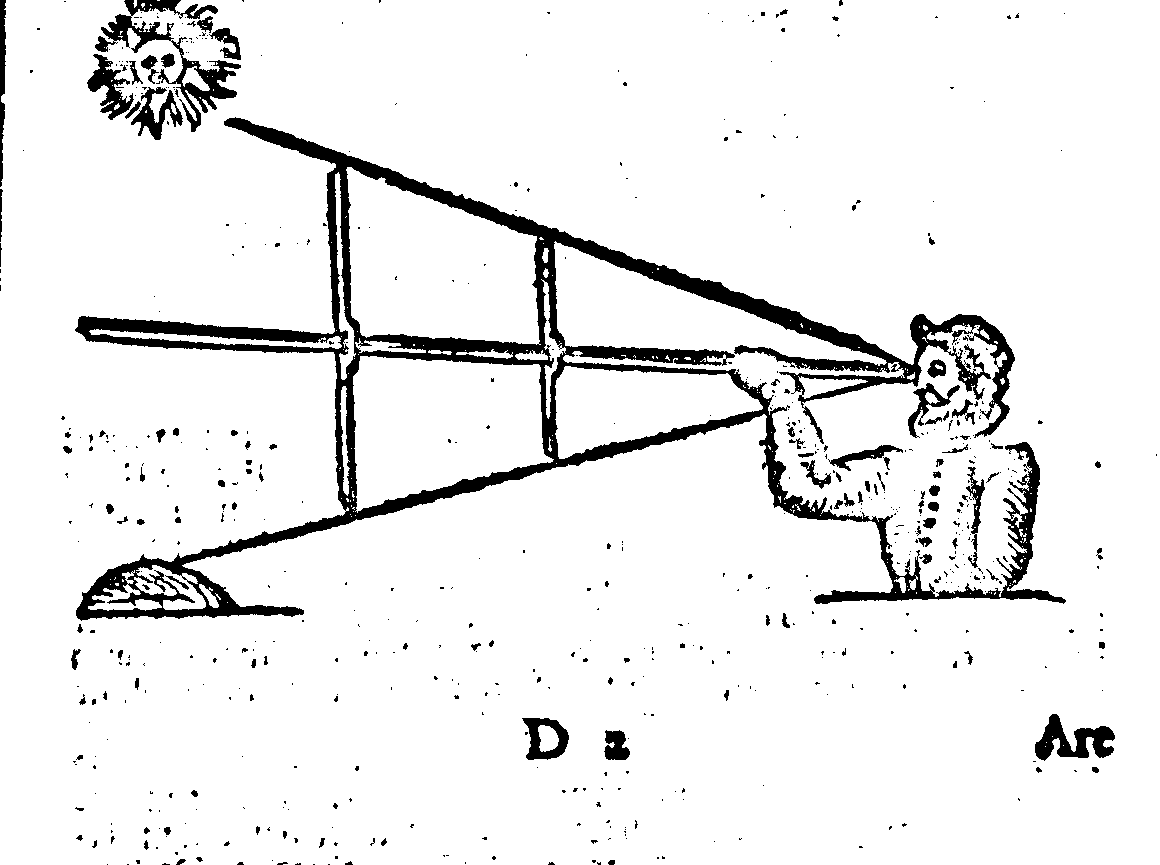
Because the Staff would be of unreasonable length to contain more
than
than 60 degrees, therefore to keep him in due form for the ease of his use,
and that the complement of 90 deg. should be contained upon the staff,
the other 30 are artificially projected upon the Transversary, as by this
demonstration appeareth, and in this sort consider the length of your
staff from that point S. to the last intersection which endeth in 30 deg.
lay down the length of the line I.h. at the point of v from that point
draw a right line, cutting the line I.h. to the right Angles as in the line
v.a. being just the length of half the Transversary: then divide the ark
o.d. into 45 equal parts, accounting from the point d to the point o.
then from the Angle I. draw right lines to the first 15 of those parts,
asnd as those lines do cut the line v.a. so must the Transversary be gra-
duated on both his parts, where unto vanes being framed, your staff is
finished to your use.
There is a staff of another projection, which I find by practice to be
an Instrument of very great ease and certainty at Sea. the
Sun not being more than 45 deg. above the Horizon, whose use is con-
trary to the other before demonstrated, for by this Staff the beam of the
Sun shadowing upon the Transversary, doth thereby give the height
most precisely, not regarding how to place the center of the staff to the
Eye, for the correction of the parallax of the sight, and without looking
upon the Sun, shose demonstration is thus:
Draw two right lines, cutting each other at right Angles, as do the
lined d.v. and d.s. upon the ANdle d. describe a quarter circle, as is
the ark v.s. divide that Quadrant into two equal parts by the line d.n.
cutting the Quadrant into point h. divide the ark s.h. to every of those
divisions, then from the point I. bring the third part of the line d.s. up-
on the Center d. describe the ark of a Circle, as is the ark I.o. which
is for the Transversary of this staff, and the line d.s.is for the staff,then
from the point o. where the upper end of the Transversary toucheth the
line d.n. draw a Parallel to the line d.s. as in the line o.y. and as that
line doth cut the lines, drawn from the Center k. so must the staff d.s.
be graduated, laying it upon the line o.y. putting that part of the staff
where the point I. toucheth, upon the point o. and then from the point
I. lay down degrees, as are the intersections upon the line o.y. and so
is the staff graduated.
The
v
|
|
|
|
|
|
|
|
|
|
|
|
|
y |
|
|
|
|
______________________________________________________|
s i d
o
a \\
] \\
45|| 25 15
==============||)======================================
i
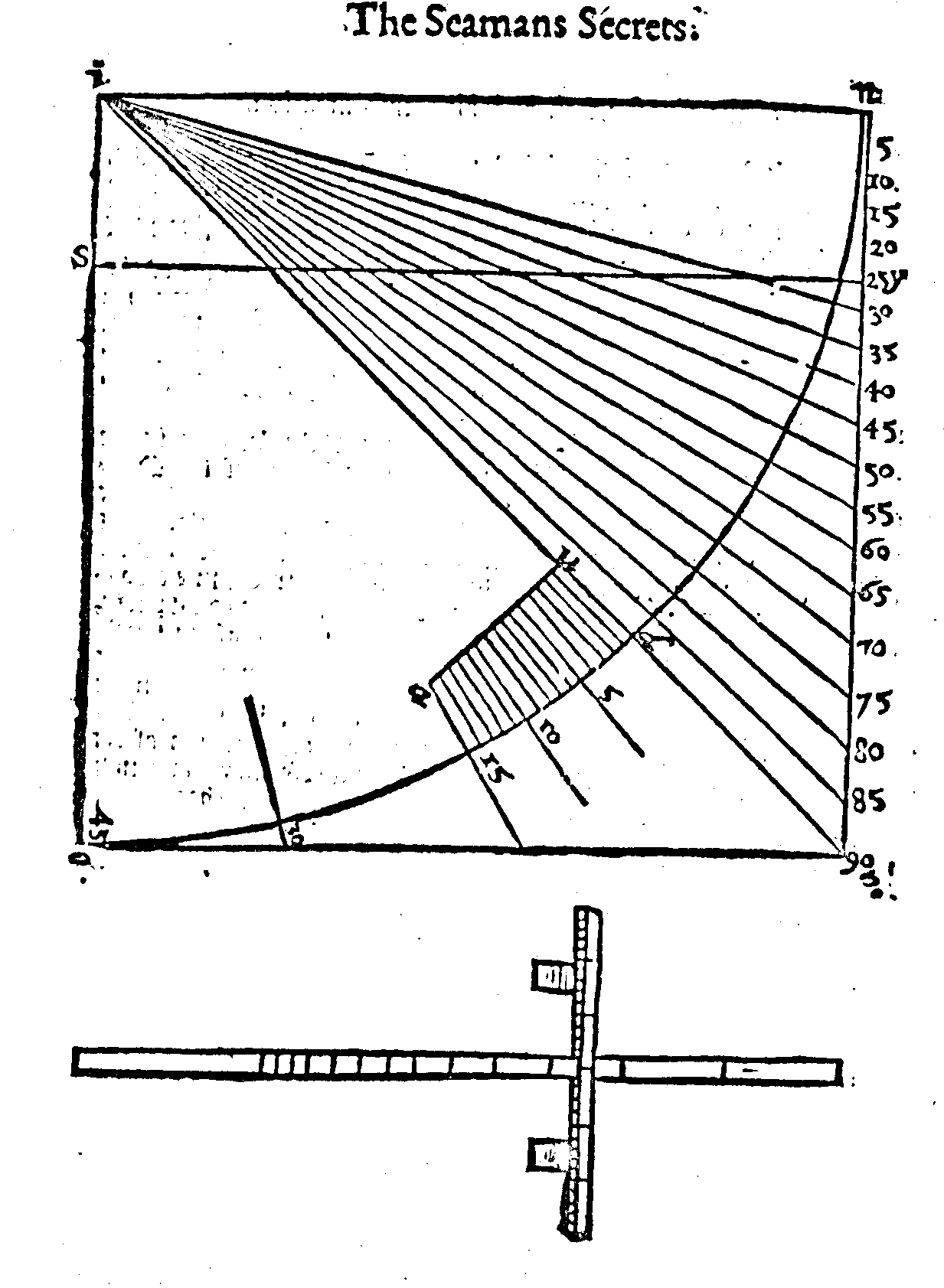
The transversary at the point i. must have an artificial hole made for
the staff to run in,as the other staves have, also there must be a plate of
__als with a soccat to be set to the center of the staff, as is the figure 2.
in the mid_ whereof there must be a slit, through which the light must
be conveyed to the Horizon, and this plate must receive the shadow ot
the transversary, and so the staff is finished.
How
How is the use of this staff ?
Thus use of this staff is altogether contrary to the other, for the center
of this staff where the brass plate is fastned, must be turned so that
part of the horizon which is from the Sun. and with your back toward
the Sun, by the lower edge of the half cross, and through the slit of the
plate you must direct your slght only to the Horizon, and then moving
its Transversary as occasion requireth, until the shadow if your upper
edge of the Transversary do fall directly upon the same slit or long hole,
ans also at the same instant you see the Horizon through the slit, and then
the Transversary sheweth the height observed.
| \|/ ---( )--- / | \
\\ \\ to || Horizon []========================||====================== []
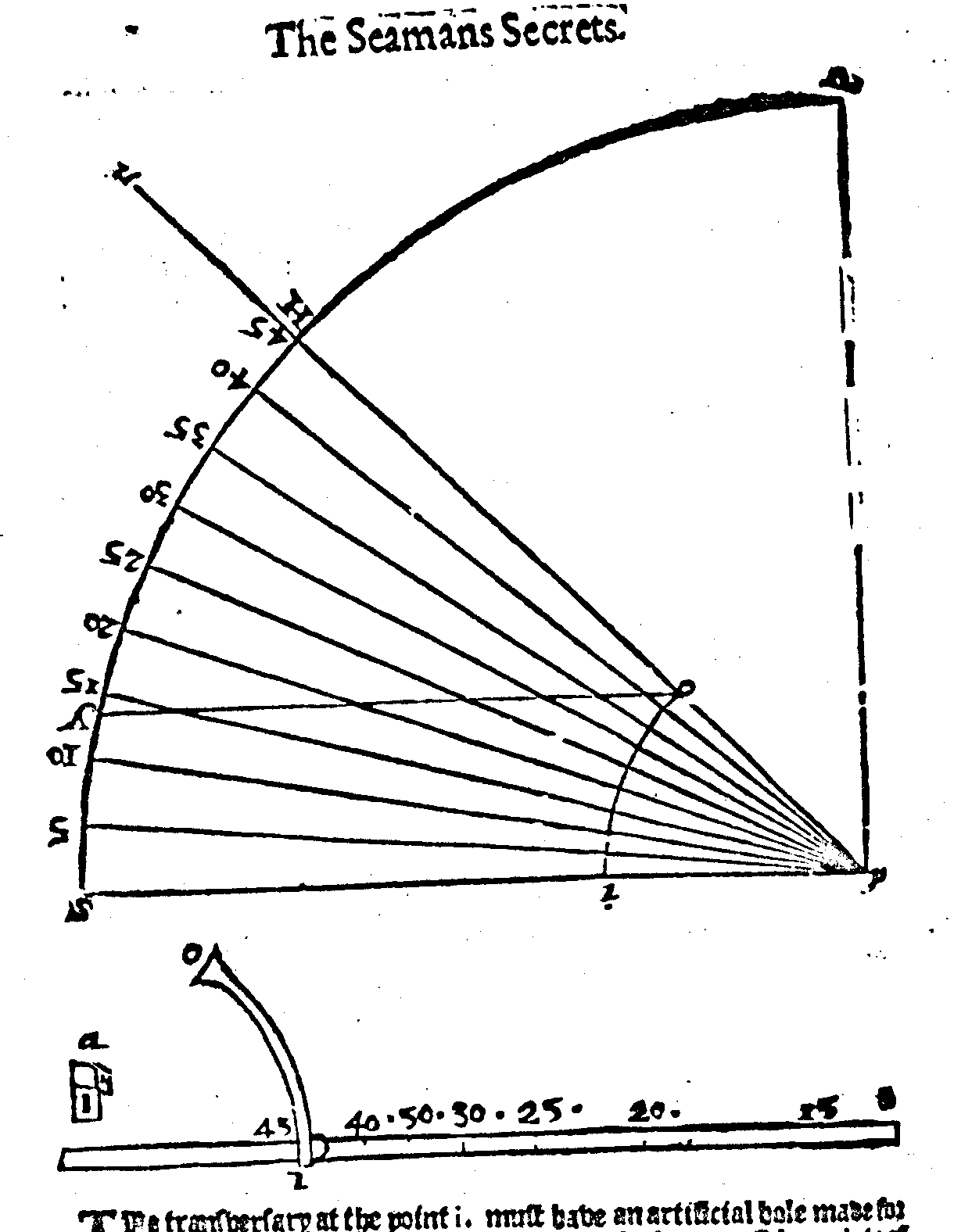
Finding by practice the excellency of the Cross-staff above all other In-
struments, to satisfie the Seamans expectatien, & also knowing that
those instruments whose degrees are of largest capacity, are instruments
of most certainty. I have very carefuly labored to search a good and de-
monstrable mean how a cross-staff might be projected, not only to con-
tain large degreee, but also to avoid the uncertainty of the sight, by disor-
derly
derly placing of the staff to the eye, which demonstration I have found,
and have had the Instrument in practice, a___el under the Sun, as in o-
ther Climates but because it hath a large demonstration, with mani-
fold uses, I here omit to manifest the same, purposing to write a par-
ticular treatise thereof, notwithstanding his Form and use, by picture
I have thought good to expess.
This staff is a yard long, having two half crosses, the one circular, the
other strait, the longest not 14 inches, yet this staff doth contain the
whole 90 degrees, the shortest degree being an inch and 1/4 long, wherein
the minutes are particularly a very sensibly laid down, by which staff
not regarding the parallax of your sight, nor looking upon the Sun, but
only upon the Horizon, the Suns height is most precisely known, a___el
and as easily in the Zenith, as in any other part of the heaven. As
which Instrument (in my opinion) the Seaman whall not find any so
good, and iu* all Climates of so great certainty, the Invention and de-
monstration whereof I may boldly challenge to appertain unto my self
(as a portion of the Talent which God hath bestowed upon me, I hope
without abuse or offence to any.
(diagram of pilot using this instrument)
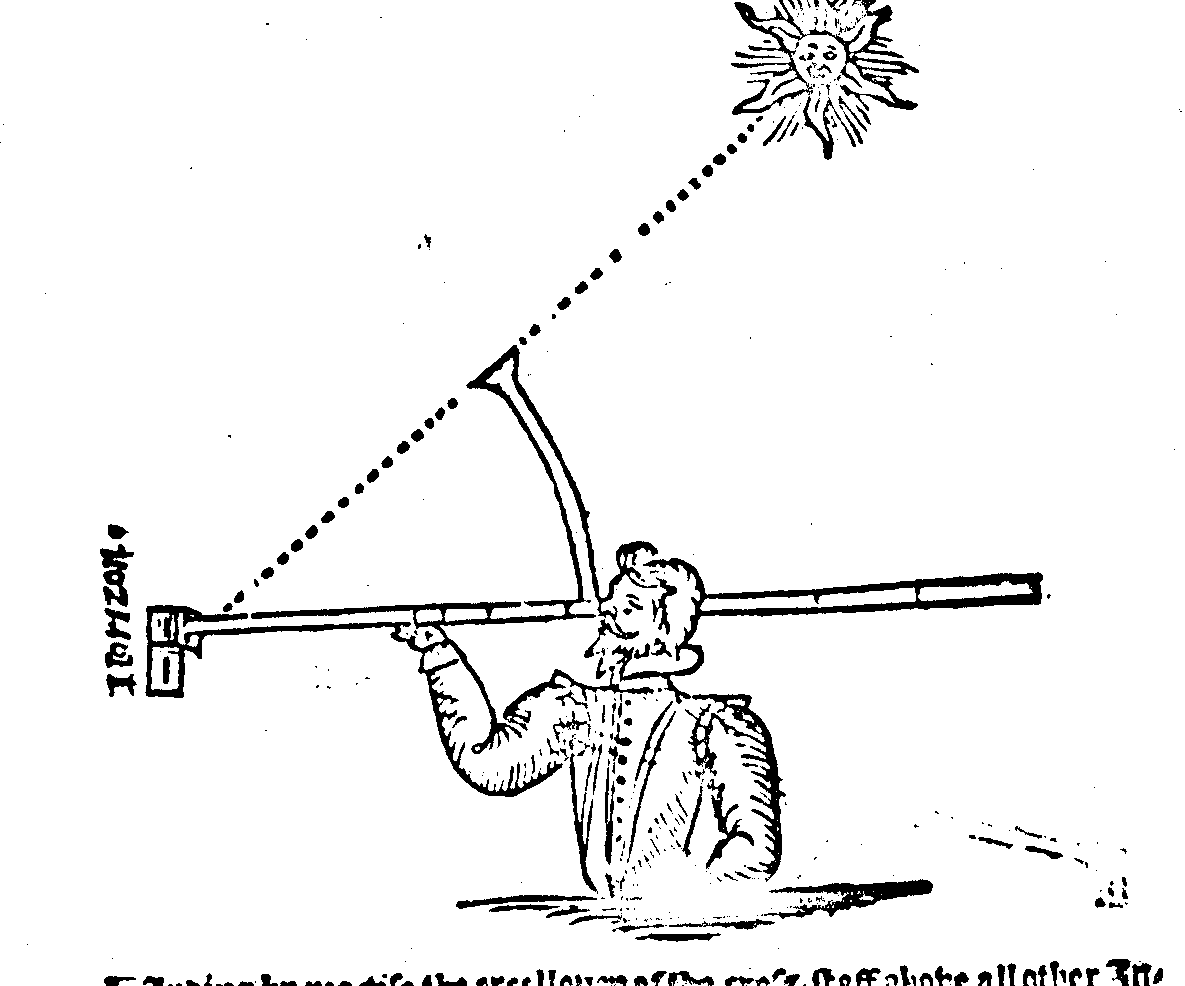
Of the Quadrant.
A Quadrant is the fourth part of a Circle, containing 90 degrees,
and representeth the distance between the Horizon & Zenth, being
an excellent Instrument upon the Shore,to perform any Astronomical
Observations, but for a Seaman it is to no purpose: & although there
may be very much written of the monnodious and excellent uses of the
Quadrant, yet not being an apt Instrument for Sea-observations, it
shall be from my purpose to write further thereof, and therefore the on-
ly laying doen of this form, may at this present sufice.
(diagram of quadrant)
[] [] ======================================================== | | | | | | | | | | | | | | | | | |
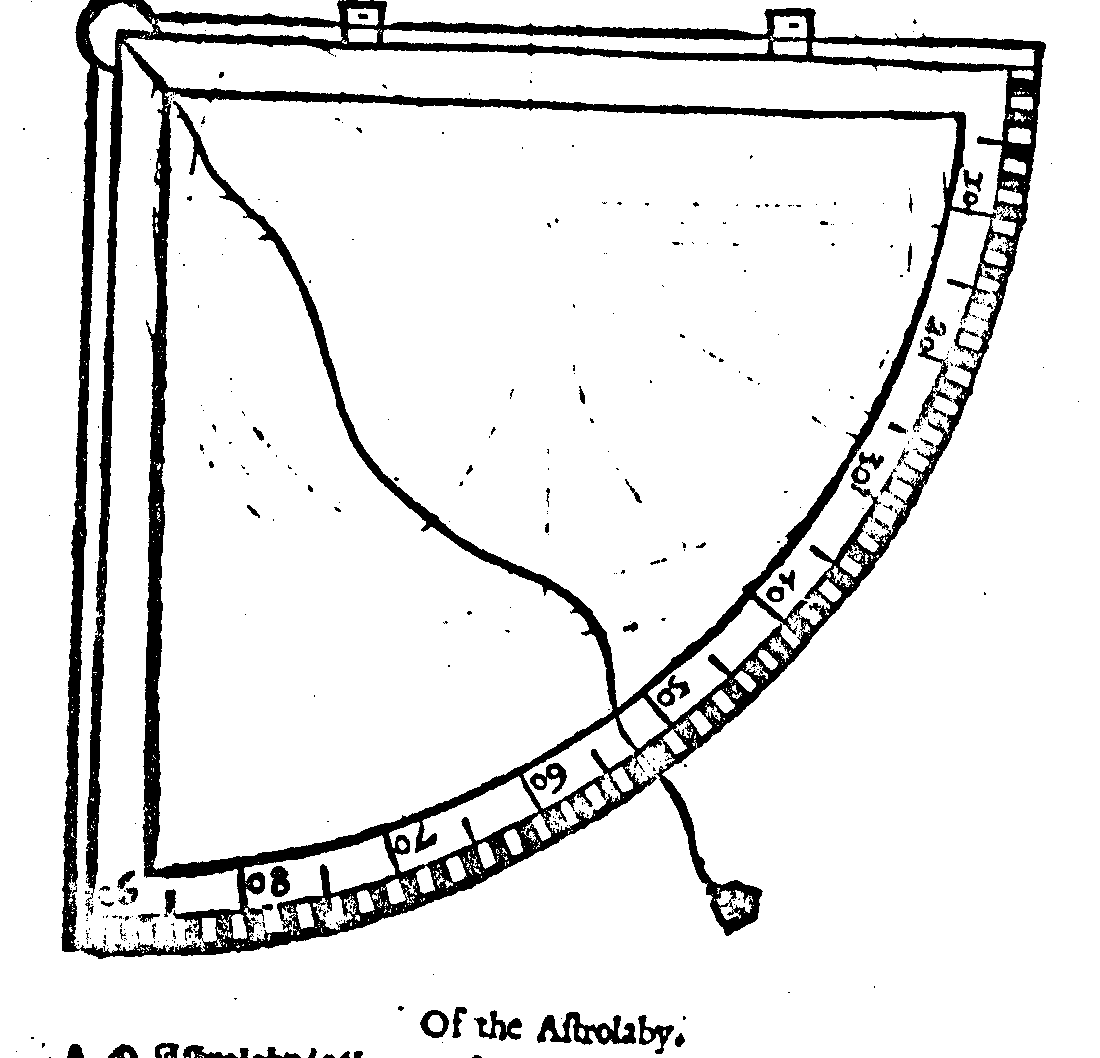
Of the Astrolaby.
An Astrolaby is the representation of a great circle, containing four
quadrants, or 360 degrees, which Instrument hath been in long
use among Seamen, and it is an excellent Instrument, being rightly
understood and operated, but with the vulgar Astrolaby with his use is
every
every Seaman sufficiently known, it should be vain labor for me to lay-
down his use and demonstration: Therefore by this Form it shall
suffice to express him.
O | | | | | | | | | | | | | | | | | | | | _________________________| |____________________________ -_________________________|-|____________________________- | | | | | | | | | | | | | | | | | | | | | | |
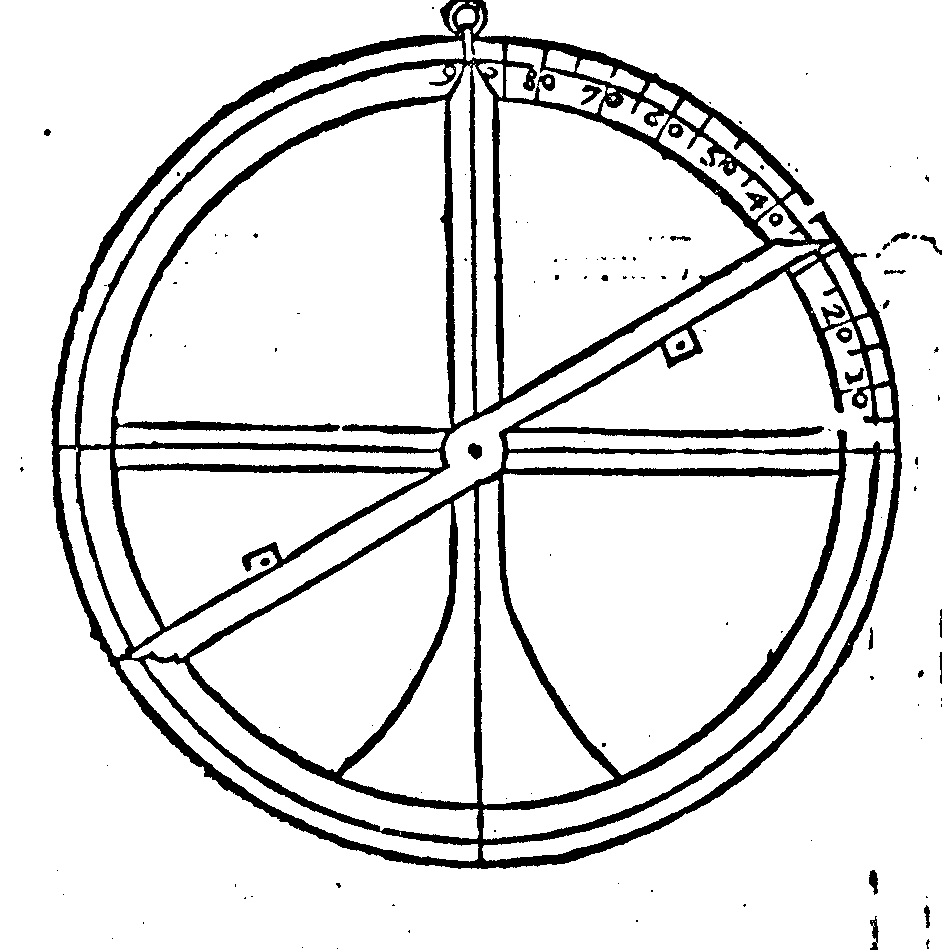
There hath been great pains taken to many, for the enlarging of the
degrees contained in an Astrolabe, among which there is a Pro
jection to convey the degres of a Quadrant into the concavity of an A-
strolaby wherely the so degrees shall be double, to any other Astrolabie,
of the same quantity, so that the Sun-beam, piercing a hole made in the
side of the Astrolaby, is thereby carried to the degrees noted in teh op-
posite concave part, as by his Form may appear.
Also my self laboring in the same matter, have found a mean whereby
an Ark of a Quadrant, whose side is 10 foot, may be convered into an
Astrolaby of 10 inches diameter, whode Dioptra shall cut his limb to
right angles, and shall perform teh complement of 90 degrees, as amplu
asn as effectually as by the Quadrant it may in any sort be done.
Whose:
Whose demonstration, together with the demonstration of my
Staff, I purpose (God willing) at large to manifest: But there can
be no Invention that can establish the certainty of th use of either
Quadrant or Astrolaby at Sea, for unless it be very smooth wa-
ter, there can be no certainty of any observation by those Instruments,
whereby the Seaman may rest assured of the Altitude which he seek-
eth but the Observations made by the Cross-staff are without all di
struct of error, and therefore no Instrument may compare with the ex-
cellence of this Cross-staff for the Seamans use.
(diagram of an astrolabe through which the Sun projects a beam of light
through a hole to give the height of the Sun.)
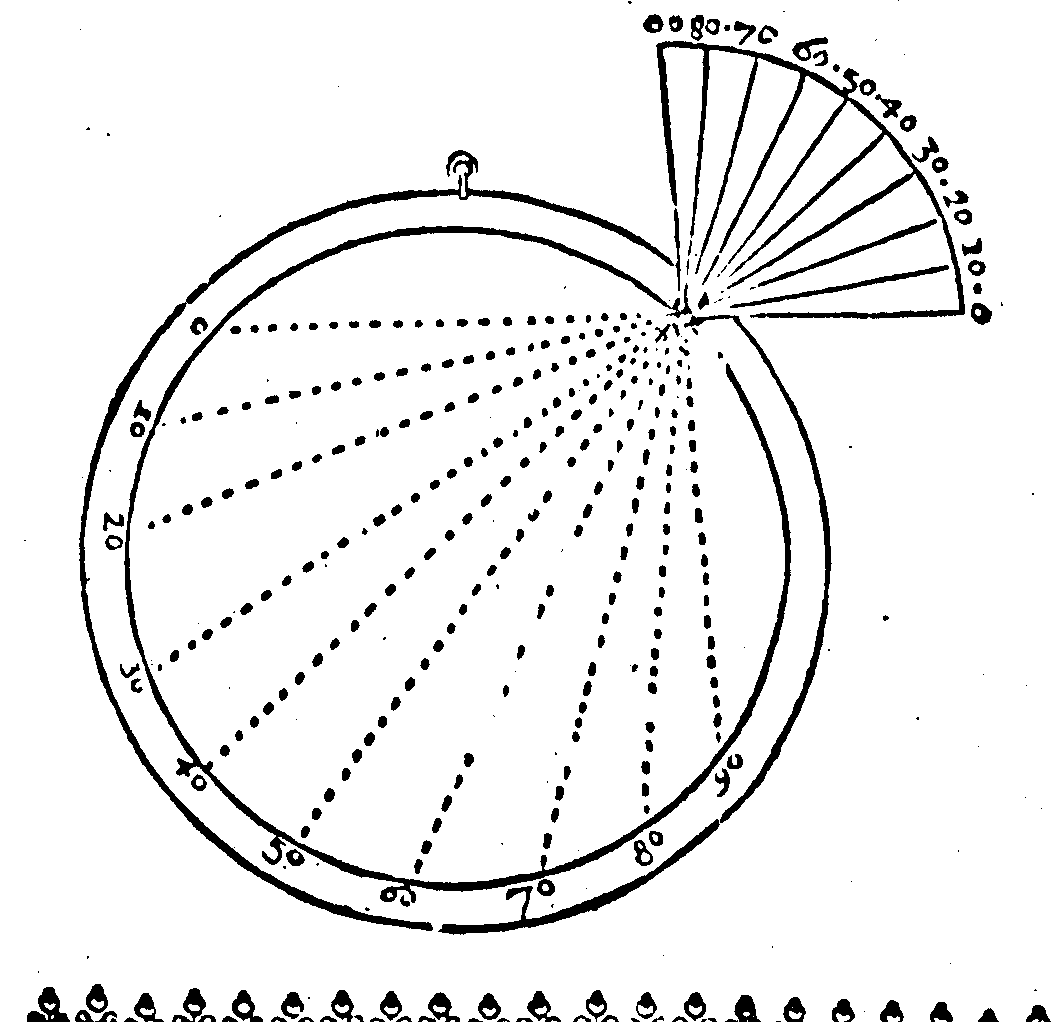
&&&&&&&&&&&&&&&&&&&&&&&&&&&&&&&&&&&&&&&&&&&&&&&&&&&&&&&&&&&&&&&
F I N I S.
&&&&&&&&&&&&&&&&&&&&&&&&&&&&&&&&&&&&&&&&&&&&&&&&&&&&&&&&&&&&&&&
Click Here to return to the First Book - or part 1 - of Seamans Secrets.
Click Here to go to the introductory material.